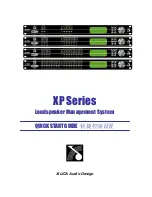
32
Troubleshooting the APL-220, -500, or -800 is a simple process. With an inte-
grated system like the APLs, there’s not much that can go wrong. If a prob-
lem does arise, it usually can be solved quickly by performing the processes
described below.
All repair work that involves dismantling the APL-220, -500, or -800 must be
performed by a qualified, trained service technician. The power cable must be
disconnected before attempting any repair work. Lethal voltages are present
inside the speakers when the power cable is connected!
(
1
) Drivers
The APL-220, -500, and -800 employ high power cone drivers and advanced
technology compression drivers. All drivers are treated with Ferrofluid
™
as
a dampening and heat conduction agent. Additionally, the surface of the cone
driver is treated with a proprietary compound that makes it highly resistant
to water damage. This compound has a secondary purpose; the cone will not
change mass due to moisture absorption in humid weather, making the sys-
tem’s sonic qualities exceptionally stable when used in varying climatic con-
ditions.
Occasionally, due to mechanical shock or abusive operation, a driver may
become dysfunctional. Drivers can fail completely, or they can fail in such a
way that they continue to reproduce sound but their output becomes
noticeably distorted. The latter is usually due to deformation of the voice
coil, resulting in the coil rubbing against the gap. In either case, driver replace-
ment is warranted.
To verify if a driver has failed, listen to the system at a moderate level and
compare it to another speaker of the same model that is known to be per-
forming properly. If distortion, rubbing, or a complete lack of output is
observed, it’s likely that driver failure has occurred although the problem
could lie elsewhere. Before attempting any repairs, consult the Quick
Troubleshooting Guide in this manual.
Before attempting to replace any parts in the APL-220, -500, or -800, be cer-
tain to disconnect the power cable from the unit. Lethal voltages are present
inside the enclosure when the unit is connected to an AC mains supply!
Low-Frequency
The low-frequency driver in the APL-220, -500, and -800 can be changed in
just a few minutes. To gain access, first remove the front protective grille with
a Phillips screwdriver. After the grille is removed, the cone driver can be
removed by simply loosening the eight (8) Allen-drive fasteners that retain it,
and lifting it out of the enclosure. If possible, perform this task with the enclo-
sure resting on its rear surface. This will ease the process and minimize the
Troubleshooting &
Field Repairs













































